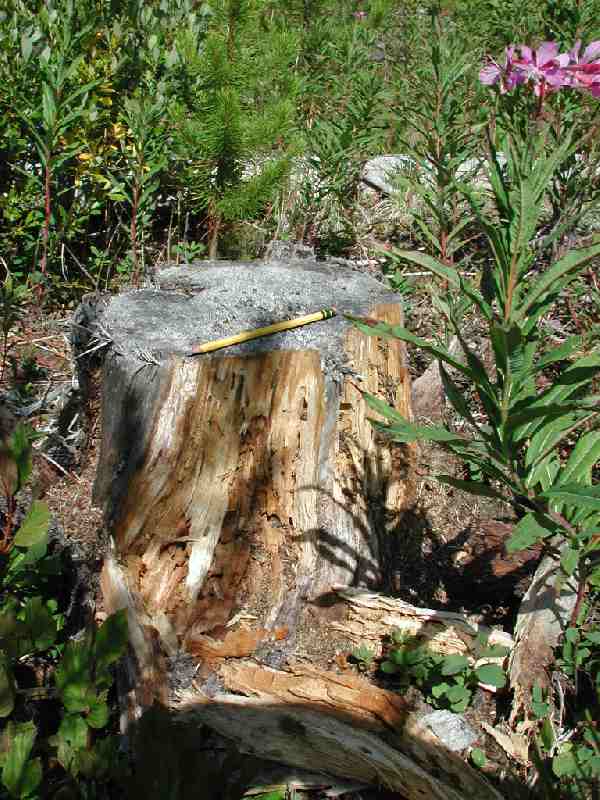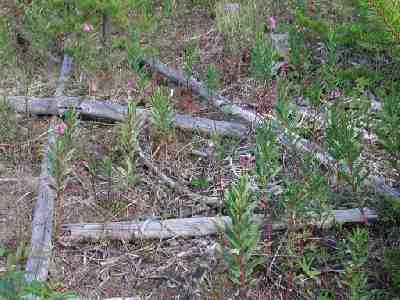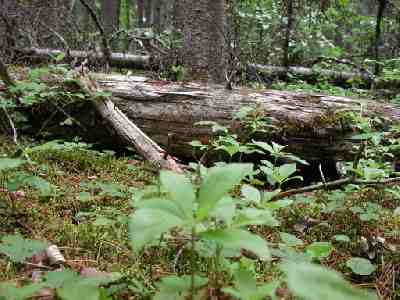Invertebrates and Coarse Woody Debris Project
Principal Investigators
Dr. Staffan Lindgren
Robert J. Higgins
University of Northern British Columbia
Funded by:
Houston Forest Products
National Science and Engineering Research Council of Canada (NSERC)

|
|
Bears often open stumps looking for ants
|
In recent years there has been a move away from considering Coarse Woody Debris (CWD) as unsalvaged waste (Maser et al. 1979) and toward an appreciation that this resource plays in both forest ecological processes (Maser et al. 1994, Stevens 1997, Lofoth 1998) and as habitat for many species (Keisker 2000). Poor CWD management can have consequences. In Sweden, a lack of CWD has contributed to the red-listing of 542 wood dependent invertebrates (Jonsell 1998). This has led to one recommendation that dead wood input following harvest increase by at least 50% in Sweden before 2010 (Ehnstrom 2001).
As recognition of the role of CWD within forest ecosystems has grown, it has now been included as a critical filter habitat and biodiversity indicator within the Canadian Standards Association sustainable forest management certificate. As a consequence industry has begun to recognize the importance of CWD as a management objective within the new Results-Based Forest and Range Practices Code. Specifically, Houston Forest Products initiated a research program (Lloyd 2001, 2002) to examine variation in CWD volume within their pre-and post harvest stands for the most common biogeoclimatic zones and site series within their forest licence.
Data from this program quickly led to an understanding that the focus on volume alone may have limited utility as a guide to managing CWD in a manner likely to promote positive ecological outcomes (Lloyd 2002). Coarse woody debris post-harvest differed significantly in several physical attributes as compared to CWD in non-harvested stands. Pieces of CWD in post-harvested stands were smaller in diameter (e.g. 77% of harvested sites had pieces in the smallest diameter class (7.6-20 cm) compared to 51% in non-harvested stands), were shorter in length (e.g. 90% of pieces in harvested areas were shorter than 10m compared to 45% in unharvested areas),were commonly splintered with less retained bark, and lacking in later decay classes (Lloyd 2002).
As a consequence of these observations Houston Forest Products became concerned that total volume was an inadequate indicator of CWD function and became interested in establishing broader indicators of CWD ecological utility (i.e. in promoting ecological utility (e.g. nurse logs, nutrient turnover etc.) and as habitat for organisms and thus improving biodiversity) (M. Todd, Senior Wildlife Biologist, Houston Forest Products. per. com. unreferenced 2002). Further, earlier work attempting to develop a vertebrate bioindicator index for another management objective failed as a consequence of large range sizes, cyclical population fluctuations,low abundance and low diversity in these forests. Thus, an interest in using invertebrates arose to overcome these limitations.

|
|
Typical pieces of CWD post harvest. Pieces tend to be short, barkless, and demonstrate mechanical damage
|
Invertebrates have been shown to function well as bioindicators of ecological disturbance. Some of the more common organisms examined include: spiders (Buddle et al 2000, Willett 2001), ground beetles (Niemela et al. 1993, Spence et al. 1996) and ants ( Majer 1983, Andersen et al 2002). In particular a number of beetles and ants have a close association with coarse woody debris (Hammond HEJ 2001, Lindgren 2002) and as such may function specifically as bioindicators of woody debris ecological utility.
It is the objective of this study to determine which physical attributes of CWD are most closely associated with biological utilization. As CWD has not been specifically managed historically there are limitations associated with the use of older post-harvest stands given that these lack some older decay classes and larger piece sizes. While this study will examine older post-harvest stands, it will also be necessary to examine how older and larger pieces of CWD respond to environmental variables typical of post-harvest stands, such as larger fluctuations in temperature and humidity. To address this limitation, this study will also examine CWD in forest edges, wildlife tree patches and burns where these environmental variables will relate more closely to post-harvest stands. This information will be used to guide CWD management on site, assist in meeting management objectives under the Result-Based Code, and promote management more closely associated with natural disturbances.

|
|
Decay Class 3 CWD in unmanaged forest
|
Overall three questions will be examined in order to generate specific recommendations regarding coarse woody debris management for post-harvest sites. These are:
1) What physical attributes of CWD best predict bioutilization?
2) How do species assemblages (e.g. total species composition, invertebrate functional groups, etc.) vary with respect to site and sampling technique?
3) How do CWD associated species assemblages compare with stand level assemblages?
All photographs by R. Higgins unless otherwise noted.
|



